List of victims groups in northern Uganda (pdf)
From JRP Field Note XVI: Paying Back What Belongs to US
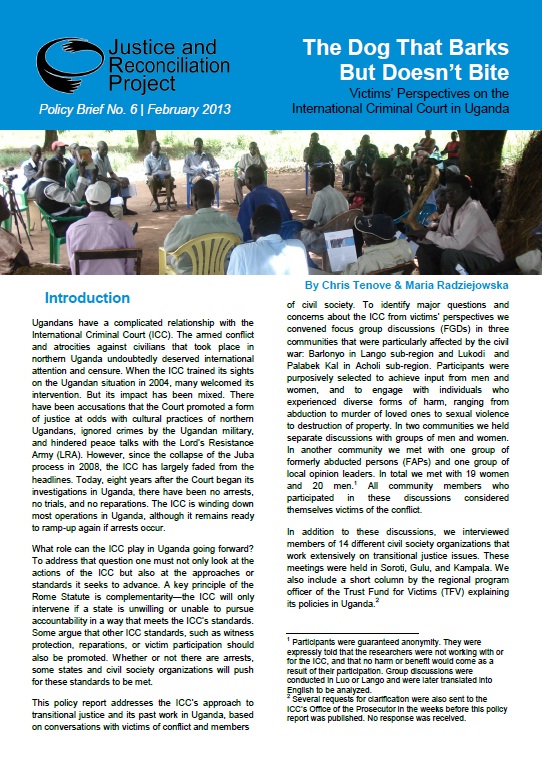
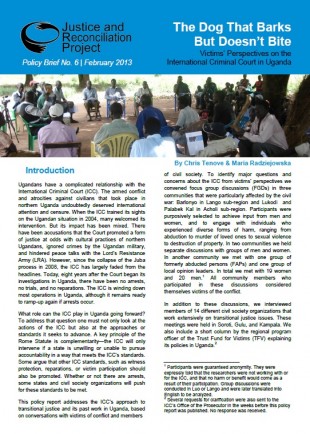 Ugandans have a complicated relationship with the International Criminal Court (ICC). The armed conflict and atrocities against civilians that took place in northern Uganda undoubtedly deserved international attention and censure. When the ICC trained its sights on the Ugandan situation in 2004, many welcomed its intervention. But its impact has been mixed. There have been accusations that the Court promoted a form of justice at odds with cultural practices of northern Ugandans, ignored crimes by the Ugandan military, and hindered peace talks with the Lord’s Resistance Army (LRA). However, since the collapse of the Juba process in 2008, the ICC has largely faded from the headlines. Today, eight years after the Court began its investigations in Uganda, there have been no arrests, no trials, and no reparations. The ICC is winding down most operations in Uganda, although it remains ready to ramp-up again if arrests occur.
Ugandans have a complicated relationship with the International Criminal Court (ICC). The armed conflict and atrocities against civilians that took place in northern Uganda undoubtedly deserved international attention and censure. When the ICC trained its sights on the Ugandan situation in 2004, many welcomed its intervention. But its impact has been mixed. There have been accusations that the Court promoted a form of justice at odds with cultural practices of northern Ugandans, ignored crimes by the Ugandan military, and hindered peace talks with the Lord’s Resistance Army (LRA). However, since the collapse of the Juba process in 2008, the ICC has largely faded from the headlines. Today, eight years after the Court began its investigations in Uganda, there have been no arrests, no trials, and no reparations. The ICC is winding down most operations in Uganda, although it remains ready to ramp-up again if arrests occur.
What role can the ICC play in Uganda going forward? To address that question one must not only look at the actions of the ICC but also at the approaches or standards it seeks to advance. A key principle of the Rome Statute is complementarity—the ICC will only intervene if a state is unwilling or unable to pursue accountability in a way that meets the ICC’s standards. Some argue that other ICC standards, such as witness protection, reparations, or victim participation should also be promoted. Whether or not there are arrests, some states and civil society organizations will push for these standards to be met.
This policy report addresses the ICC’s approach to transitional justice and its past work in Uganda, based on conversations with victims of conflict and members of civil society. To identify major questions and concerns about the ICC from victims’ perspectives we convened focus group discussions (FGDs) in three communities that were particularly affected by the civil war: Barlonyo in Lango sub-region and Lukodi and Palabek Kal in Acholi sub-region.
In addition to these discussions, we interviewed members of 14 different civil society organizations that work extensively on transitional justice issues. These meetings were held in Soroti, Gulu, and Kampala. We also include a short column by the regional program officer of the Trust Fund for Victims (TFV) explaining its policies in Uganda.
Read the entire brief here: The Dog That Barks But Does Not Bite (pdf).
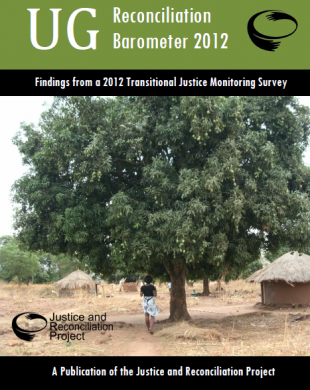
In November 2012, JRP released the first issue of the UG Reconciliation Barometer, a report which seeks to present the findings survey findings from seven districts across the Acholi sub-region. Research for it was conducted in all 60 sub-counties across those districts, including former IDP camps, rural communities, urban and semi-urban areas.
The report measures the attitudes and perceptions of northern Ugandans on critical justice and reconciliation issues since the relative calm restored following the relocation of LRA fighters to neighboring countries.
Click here to read the report: (pdf)
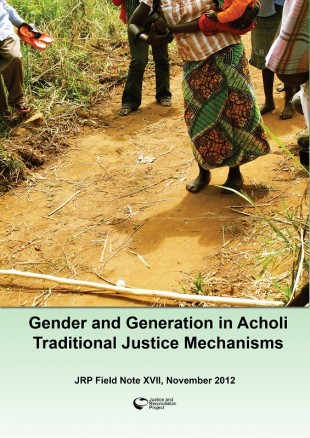
Throughout the LRA conflict women and youth faced grave atrocities such as gender-based violence, forced marriage, and disruption of education and economic opportunities. These women and youth risk being omitted from justice and peace debates in Uganda if their unique experiences and reintegration challenges are overlooked. Acholi traditional justice mechanisms, especially mato oput and nyono tong gweno, are often promoted as a locally appropriate approach to address these issues in northern Uganda. Despite this, little has been documented about the attitudes of women and youth towards traditional approaches and the impacts of these practices on their processes of healing and recovery.
Based on opinions gathered from focus group discussions and individual interviews with war-affected women and youth throughout Acholi sub-region, this report explores the relevancy of traditional justice mechanisms to the unique justice, reintegration and reconciliation needs of women and youth. It also discusses their current role in the decision-making and negotiation process of traditional justice mechanisms, and whether that role sufficiently represents their needs and opinions in the healing process. Finally, specific policy recommendations are offered to key stakeholders on ideal ways to address and incorporate the concerns of women and youth into traditional justice mechanisms.
Read the entire report here: Gender and Generations in Acholi Traditional Mechanisms (pdf)
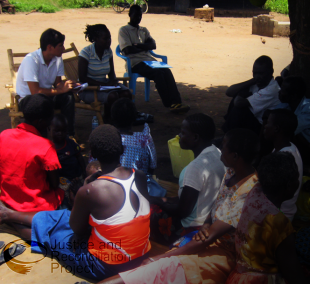
As a young researcher interning for the past months in the Documentation Department of the Justice and Reconciliation Project, I have come to experience and learn firsthand the challenges of conducting research and documentation work in war-torn communities in northern Uganda. Despite the fact that the reality on the ground in this part of the country has drastically changed over the last years, significant challenges must still be overcome if one is interested in engaging in this kind of work. I should add that as a foreigner who has never lived in northern Uganda before, the challenges naturally become much tougher. It is through the constant help and guidance of local researchers whose deep and broad knowledge of the region and local culture, that I have been able to quickly learn invaluable lessons about working with the Acholi populations of northern Uganda.
For instance, I have come to understand the relevance of seeking the assistance of local leaders or community mobilizers as we first approach a community. Their broad in-depth knowledge of the community, as well as their capacity to rally victims and serve as a point of communication between the researchers and the people is something that any researcher that does not directly belong to the community cannot compete with. The overwhelming majority of our work is carried out with populations that live in rural areas in which only a small amount of the inhabitants can be found close to a small town or a trading center and most inhabitants are rather located out in the countryside.
In addition, despite the lack of written records, the memories of those experiences endured throughout the conflict often remain deeply engraved in the minds of those that personally experience them. For this reason, I have come to learn how individual interviews then become a key tool that allows the researcher to understand what took place and how those events impacted that person’s life. However, individual interviews are not without their limitations; they are often imprecise and easily influenced by an unimaginable number of factors. In order to counter this, I have experience the importance of focus group discussions in which the participants are able to build on each other’s experiences and make us of their collective memory to clarify their account of an event. In many of these interactions the participants would challenge each other’s recollections of an incident and through this mutual dialogue it becomes much easier to reach points of general agreement.
Finally, I have learned how the long-term work in this region of numerous international organizations and aid agencies has greatly contributed to the development of a ‘research exhaustion’ in many communities. This term refers to those cases in which communities have previously interacted in repeated occasions with other NGOs, but have perhaps been severely disappointed by the results of this interaction and thus feel much more reluctant to engage once again in a new process with another organization that seems to be interested in their experience. As a way to overcome this challenge, I have come to understand the fundamental importance of developing an actual relationship with the community we are working in which there is a clear understanding of each other’s needs and expectations from the very beginning.
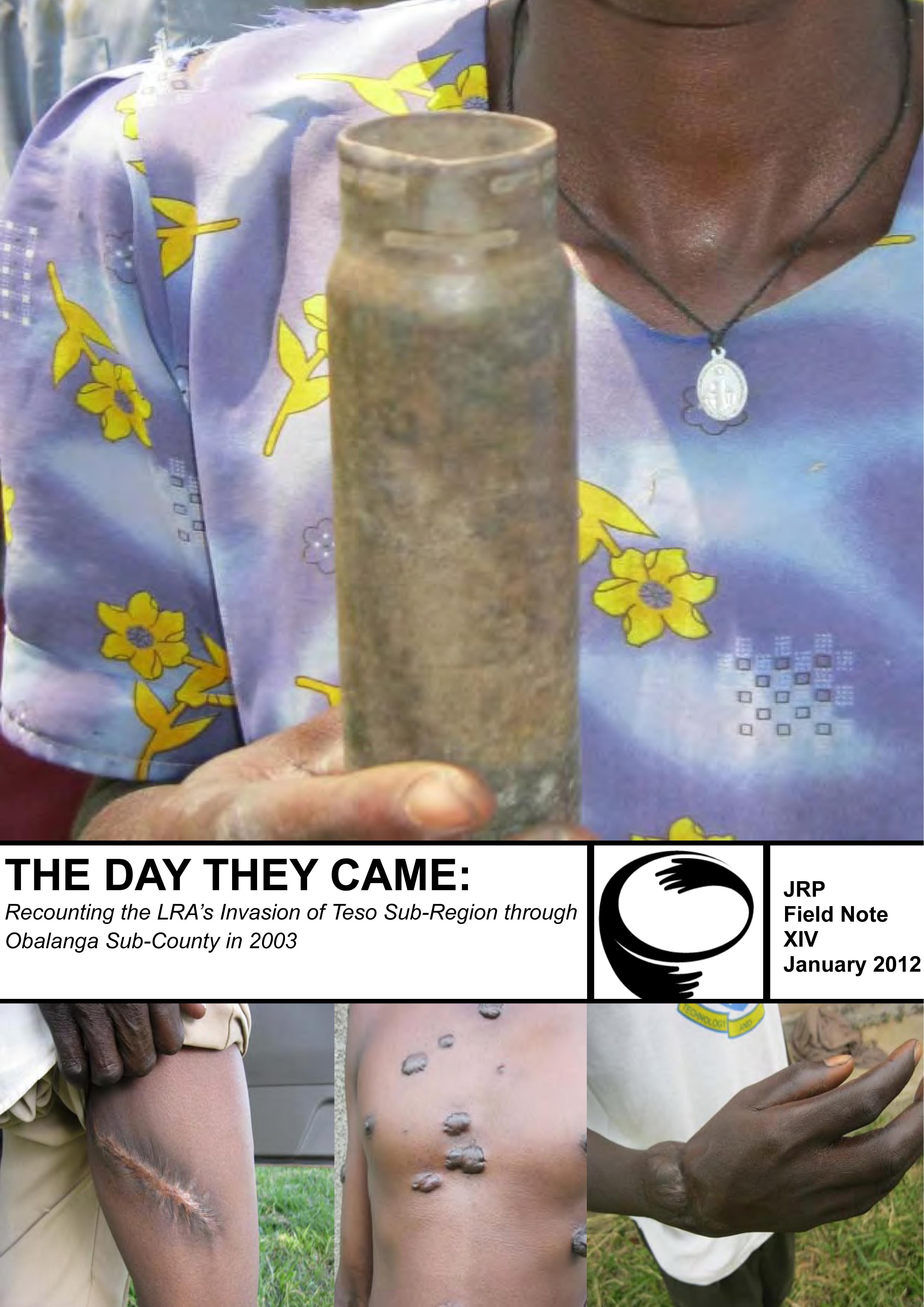
In June 2003, the LRA infiltrated Teso sub-region in eastern Uganda for the first time. The civilian population and the government army were caught unaware, a factor which had disastrous humanitarian implications. In line with their trademark pattern of atrocities, the rebel soldiers carried out killings, abductions, maiming, looting, rape burning and pillaging. By the time the UPDF repulsed them almost 8 months later, approximately 90% of the population in Teso sub-region had been displaced into internally displaced persons (IDP) camps, several thousand children had been abducted and thousands of people had lost their lives and property. This report explores the impacts of the LRA incursion into Teso sub-region using case studies and victims’ testimonies from Obalanga sub-county in Amuria district, in addition to making recommendations to relevant stakeholders.
Erratum:
Please note that the following change have been made to Field Note XIV
The heading:
“Appendix D: Identity Cards of Some of the Victims Who Perished in theHelicopter Gunship Bombings in Angica B and Morungatuny”
has been ammended to read
“Appendix D: Identity Cards of Some of the Victims and Survivors of the Helicopter Gunship Bombings in Angica B and Morungatuny”.
Read the Field Note here: The Day they Came – Obalanga – Erratum Sept 2012
Opinion on the Capture of LRA leader Caesar Acellam, NTV, 15 May 2012
Transcript not available at this time.

As part of our objective to preserve memory of conflict-affected communities through documentation, JRP’s Community Documentation department has produced video coverage of the 17th annual Attiak massacre memorial prayers, which took place on April 20th. The footage has been divided into two parts, with both available below, here and on our YouTube page: JRPUganda.
[yframe url=’http://www.youtube.com/watch?v=XoaY28XUxpg’] [yframe url=’http://www.youtube.com/watch?v=R4lpjfoN8rA&feature=relmfu’]
The prayers were attended by the President of Uganda, H.E. Yoweri Museveni, and the Deputy Speaker of Parliament, Hon. Jacob Oulanyah. Immediately following a performance by the Attiak Massacre Survivors Association, President Museveni delivered 400,000 Ugandan shillings in cash to the association. During his speech, he further pledged 50 million Ugandan shillings ($20,000 USD) to the group.
While we welcome this acknowledgment of need for the victims in Attiak, the President’s actions further demonstrate the urgency for a comprehensive, transparent reparations policy and programme for all victims of conflict in Uganda. For more information on our recommendations for reparations, please see our policy brief, “Pay Us so We Can Forget: Reparations for Victims and Affected Communities in Northern Uganda.”
For more information on the 1995 Attiak massacre, please see our field note, Remembering the Atiak Massacre.
[yframe url=’http://www.youtube.com/watch?v=XoaY28XUxpg&feature=youtu.be’]
Part 1 of footage of the 17th annual Attiak Massacre Memorial Prayers in Attiak, northern Uganda on April 20, 2012. Filmed by the Justice and Reconciliation Project (JRP).
[yframe url=’http://www.youtube.com/watch?v=R4lpjfoN8rA&feature=relmfu’]
Part 2 of footage of the 17th annual Attiak Massacre Memorial Prayers in Attiak, northern Uganda on April 20, 2012. Filmed by the Justice and Reconciliation Project (JRP).

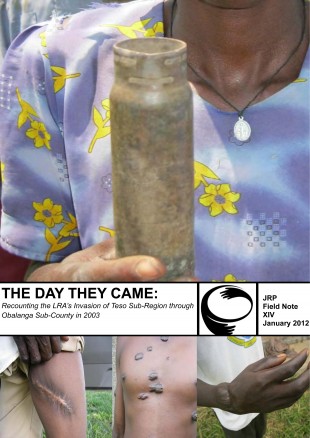
We are pleased to announce the launch of our latest publication, a field note titled, The Day They Came: Recounting the LRA’s Invasion of Teso Sub-region through Obalanga Sub-county in 2003.
To read the full report, please click here.
Our team will be launching this publication in Amuria town on Tuesday, March 13th at CV Villa beginning at 9:30am, and at the Obalanga sub-county headquarters at 1:30pm on Wednesday, March 14th.
A radio talk show will be held on Etop Radio from 7pm to 8pm on March 13th. The public is invited to attend either of the launches or tune into the radio programme.